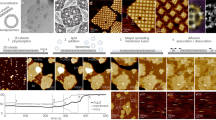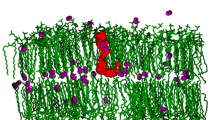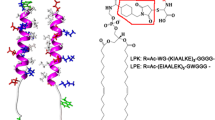Abstract
THE phospholipid bilayer1 in certain biological membranes is maintained so that the range of temperature over which the gel-to-liquid crystal transition occurs includes the environmental temperature2. As a result, clusters of phospholipid molecules in crystalline and liquid-crystalline states1 coexist in the membrane and the isothermal lateral compressibility of the membrane lipids is enhanced3. Any increase in compressibility should facilitate insertion of foreign molecules into the bilayer thereby affecting transport across the membrane. Indeed, there is evidence that transport of ions4,5 and sugars3, and penetration of an enzyme6 is increased when the chain-melting transition of the lipids occurs. The lateral compressibility of phospholipid bilayers has not been measured, however, and there is no direct evidence for an increase in compressibility at the point where the gel-to-liquid crystal phase transition occurs. In order to measure lateral compressibility, compression solely in the plane of the bilayer is required. Such directed compression of bilayers will be difficult but it can be readily achieved with monolayers at the air–water interface. Since the molecular packing in such monolayers of phospholipids is equivalent to that in bilayers dispersed in excess water1,7, this model system is particularly convenient for exploring the role of lateral compressibility. Here we show (1) how the compressibility of lecithin mono-layers varies with packing density and changes at the chain-melting transition, and (2) how penetration of a hydrophobic protein is dependent on the compressibility.
This is a preview of subscription content, access via your institution
Access options
Subscribe to this journal
Receive 51 print issues and online access
$199.00 per year
only $3.90 per issue
Buy this article
- Purchase on Springer Link
- Instant access to full article PDF
Prices may be subject to local taxes which are calculated during checkout
Similar content being viewed by others
References
Phillips, M. C., Prog. Surface Membrane Sci., 5, 139–221 (1972).
Melchior, D. L., Morowitz, H. J., Sturtevant, J. M., and Tsong, T. Y., Biochim. biophys. Acta, 219, 114–122 (1970).
Linden, C. D., Wright, K. L., McConnell, H. M., and Fox, C. F., Proc. natn. Acad. Sci. U.S.A., 70, 2271–2275 (1973).
Papahadjopoulos, D., Jacobson, K., Nir, S., and Isac, T., Biochim. biophys. Acta, 311, 330–348 (1973).
Wu, S. H. W., and McConnell, H. M., Biochem. biophys. Res. Commun., 55, 484–491 (1973).
Op Den Kamp, J. A. F., De Gier, J., and Van Deenen, L. L. M., Biochim. biophys. Acta, 345, 253–256 (1974).
Phillips, M. C., and Chapman, D., Biochim. biophys. Acta, 163, 301–313 (1968).
Paltauf, F., Hauser, H., and Phillips, M. C., Biochim. biophys. Acta, 249, 539–547 (1971).
Phillips, M. C., Evans, M. T. A., and Hauser, H., Proc. sixth int. Congress Surface Activity, 2, 381–391 (Carl Hanser, Munich, 1973).
Davis, M. A. F., Hauser, H., Leslie, R. B., and Phillips, M. C., Biochim. biophys. Acta, 317, 214–218 (1973).
Adams, D. J., Evans, M. T. A., Mitchell, J. R., Phillips, M. C., and Rees, P. M., J. Polymer Sci., C 34, 167–179 (1971).
Dervichian, D. G., J. chem. Phys., 7, 931–948 (1939).
Mayer, J. E., and Streeter, S. F., J. chem. Phys., 7, 1019–1025 (1939).
Harkins, W. D., Young, J. F., and Boyd, G. E., J. chem. Phys., 8, 954–965 (1940).
Joly, M., J. Colloid Sci., 5, 49–70 (1950).
Harkins, W. D., in Physical Chemistry of Surface Films, 135–138 (Reinhold, New York, 1952).
Gregg, S. J., in The Surface Chemistry of Solids, first ed., 80–89 (Chapman and Hall, London, 1951).
Gaines, G. L., in Insoluble Monolayers at Liquid-Gas Interfaces, 156–188 (Interscience, New York, 1966).
Stanley, H. E., in Introduction to Phase Transitions and Critical Phenomena, 96–98 (Clarendon, Oxford, 1971).
Blank, M., J. phys. Chem., 66, 1911–1918 (1962).
Rosano, H. L., and La Mer, V. K., J. phys. Chem., 60, 348–353 (1956).
Colacicco, G., Lipids, 5, 636–649 (1970).
Dawson, R. M. C., and Quinn, P. J., Adv. exp. Med. Biol., 14, 1–17 (1971).
Phillips, M. C., Evans, M. T. A., and Hauser, H., Adv. Chem. (in the press).
Papahadjopoulos, D., Cowden, M., and Kimelberg, H., Biochim. biophys. Acta, 330, 8–26 (1973).
Author information
Authors and Affiliations
Rights and permissions
About this article
Cite this article
PHILLIPS, M., GRAHAM, D. & HAUSER, H. Lateral compressibility and penetration into phospholipid monolayers and bilayer membranes. Nature 254, 154–156 (1975). https://doi.org/10.1038/254154a0
Received:
Issue Date:
DOI: https://doi.org/10.1038/254154a0
This article is cited by
-
Room temperature XFEL crystallography reveals asymmetry in the vicinity of the two phylloquinones in photosystem I
Scientific Reports (2021)
-
Shear-stress sensitive lenticular vesicles for targeted drug delivery
Nature Nanotechnology (2012)
-
The membranotropic activity of N-terminal peptides from the pore-forming proteins sticholysin I and II is modulated by hydrophobic and electrostatic interactions as well as lipid composition
Journal of Biosciences (2011)
-
Composition-driven Surface Domain Structuring Mediated by Sphingolipids and Membrane-active Proteins
Cell Biochemistry and Biophysics (2008)
-
Surface pressure‐dependent cross‐modulation of sphingomyelinase and phospholipase A2 in monolayers
Lipids (1998)
Comments
By submitting a comment you agree to abide by our Terms and Community Guidelines. If you find something abusive or that does not comply with our terms or guidelines please flag it as inappropriate.



